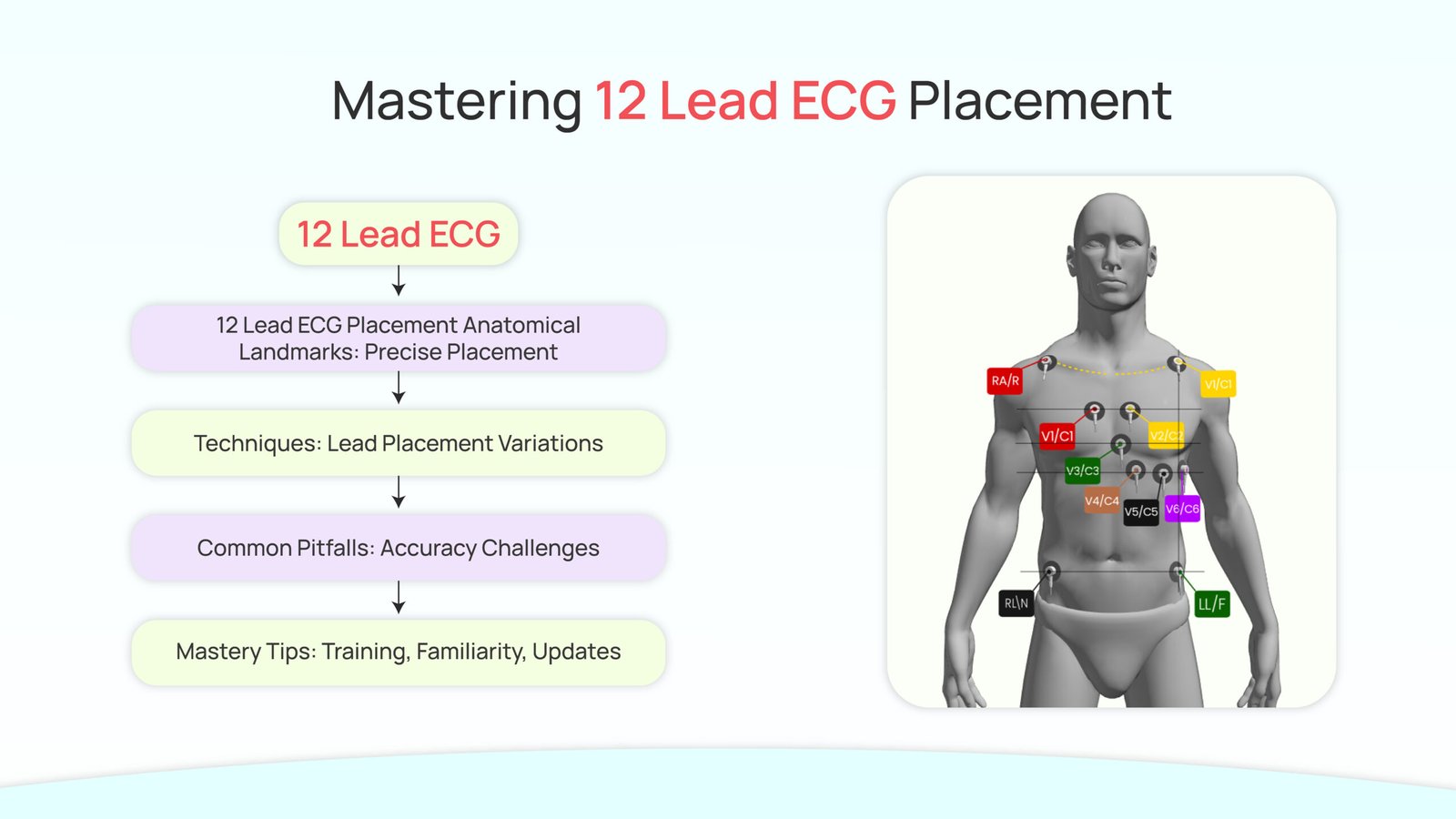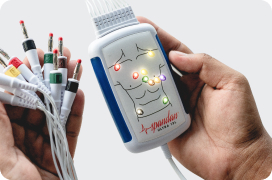
Author:- Mr. Ritesh Sharma
Mastering 12 Lead ECG placement is paramount in clinical settings. The 12 lead ECG test is the traditional ECG test through which the human heart’s electrical activity is gauged through electrodes, leads, an amplifier, and a recording device. This test is an integral part of cardiac care providing insights into the heart abnormalities to the patients. Therefore, learning the 12 Lead ECG Placement is essential for detecting these abnormalities with utmost precision. The accurate electrode placement in the ECG test is important for obtaining correct ECG readings in the recording device.
The concept of 12 Lead ECG placement might be intricate but it is important to learn in the domain of cardiac care. In this blog, we will delve into the intricacies of 12-lead ECG placement and uncover worthy insights. We will provide step-by-step instructions for the placement of all ECG components in the test. Moreover, we will also discuss the anatomical landmarks, and common pitfalls and give you essential tips to master this clinical activity.
Anatomical Landmarks of 12 Lead ECG Placement
For the proper placement of electrodes in the 12-lead ECG test, first of all, you must learn the anatomical landmarks on the body of the patient. These anatomical landmarks dictate the reference points for the precise ECG lead positioning. For the electrode placement The fourth intercostal space, along the midclavicular line is commonly used. Apart from this, finding the sternal notch and xiphoid process ensures the seamlessness in electrode placement. It is important to understand the anatomy of the chest aids to place the electrodes at the correct positions and get accurate readings in the ECG test.
12 Lead ECG Placement Techniques
The 12 lead ECG system consists of several leads with each lead indicating a different perspective of the heart’s electrical activity. To detect heart abnormalities accurately through abnormal ECG and capture specific cardiac regions, it is paramount to place the leads in the body accurately. The techniques of lead placement vary in accordance with the lead system which is used. For example, the standard limb leads (I, II, III), augmented limb leads (aVR, aVL, aVF), and precordial leads (V1-V6). It is crucial for healthcare professionals to make themselves familiar with the electrode placement for each lead to obtain accurate and comprehensive ECG data.
Common Pitfalls and Troubleshooting
Mastering 12 Lead ECG placement is no cakewalk. Many factors act as hindrances in the way of healthcare professionals. The common pitfalls and troubleshooting for the 12 lead ECG placement are as follows:-
- Incorrect Electrode Placement: Sometimes, healthcare professionals place the electrodes incorrectly in the body of the patient. This leads to inaccurate ECG readings in the test.
- Inadequate Skin Preparation: Inadequate skin preparation prior to the ECG test also causes inaccurate readings in the report of the test.
- Patient’s Movement During Recording: If the patient makes any movements during the recording, then the electrodes can move from the target position causing inaccuracies in the report.
- Obesity, Chest Hair, and Anatomical Variations: All these factors can complicate the lead placement and ensure inaccurate readings in the test.
To mitigate all these risks, healthcare professionals need to ensure that the patient is lying down comfortably and the skin preparation is proper. Furthermore, for the secure attachment of electrodes to the patient’s body, healthcare professionals must utilize electrode adhesives made available to them. The troubleshooting techniques that healthcare professionals can use if some blunder happens are lead switching and electrode repositioning. This can help address recording errors and optimize ECG quality.
Tips for Mastery
To master the 12 Lead ECG Placement skills, doctors require practice, patience, and most importantly attention to detail. The following are some tips that can help healthcare professionals master the skills of 12 lead ECG placement.
- Regular Training Sessions: Healthcare professionals can hone their skills through regular training sessions involving utilizing simulation tools, and seeking feedback from experienced peers.
- Familiarity with Anatomical Landmarks and Lead Placement Guidelines: To learn the skill of electrode placement, healthcare professionals must familiarize themselves with anatomical landmarks in the human body and go through all the lead placement guidelines.
- Stay Updated on Advancements in ECG technology: Healthcare professionals must stay updated on all advancements in ECG technology. For example, they must make themselves aware of all the technology used in the recently developed portable ECG.
- Continuous Learning and Refinement of Skills: Through continuous learning and refinement of skills, healthcare professionals can master the skills of 12 Lead ECG placement and ensure the accuracy of their ECG tests.
12 Lead ECG Placement in Portable ECG Devices
With the innovation of portable ECG devices, 12 lead ECG placement has also significantly changed. Portable ECG devices like Spandan ECG perform 12 lead ECG test that detects all heart abnormalities ranging from heart palpitations to cardiac arrhythmias to heart attacks. While the device performs the 12 Lead ECG test similarly to traditional ECG monitoring, the lead placement in it accordingly varies.
However, what gives portable ECG devices like Spandan legacy the essential edge is that even general users can perform a 12-lead ECG test through it. They just need to go through the manual provided with the device and place the electrodes accordingly.
In conclusion, mastering the 12 Lead ECG placement is a necessary practice for any cardiologist or anyone remotely associated with cardiac care. You must familiarize yourself with the anatomical landmarks and learn the placement of electrodes in the body of the patient. Additionally, with the technological advancements of ECG, you must learn more about the same test in portable ECG devices to generate accurate recordings in the ECG test reports.




